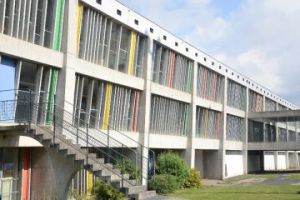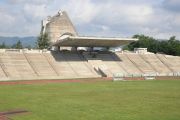 |
 |
Firminy-Vert, a major work by Le Corbusier |
 |
 |

|
 Cultural Centre © Thierry Joly Cultural Centre © Thierry Joly

|
Near Saint-Etienne, Firminy-Vert boasts one of the finest examples of 20th century architecture. Representative of post-war utopias, this district allow visitors to discover different facets of Le Corbusier's talent.
[ Practical ]
Getting there
- By road
530 km from Paris on autoroutes A6 and A47 till Saint-Etienne, then on N88 till Firminy.
- By train
TGV from Paris Gare de Lyon to Lyon Perrache, then TER from Lyon Perrache to Firminy.
TGV from Paris Gare de Lyon to Saint-Etienne Chateaucreux, then bus from Saint-Etienne to Firminy.
The journey takes 4 h.
Lodging
- Hotels
L’Abribis, in Firminy
Ibis Hôtel and Novotel Saint-Etienne gare Chateaucreux
- Bed and breakfast in Le Corbusier’s dwelling unit
Homestay Le Corbusier 5e rue
La Troisième Rue
Restaurants
I Everest, à Firminy
Garagna, à Firminy
Site Le Corbusier
Boulevard Périphérique du Stade, 42700 Firminy
Open every day except Tuesday from 10am à 12.30pm and from 1.30pm to 6pm, et de 13 h 30 à 18 h, in winter only open Friday, Saturday and Sunday.
Entrée : €6.50 / €5.50.
Guided tour of the dwelling unit : €10 / €8.50
Tel : 0477610872
sitelecorbusier.com
Information
- Saint-Etienne Métropole tourist office
Tel : 0477493900
www.saint-etienne-hors-cadre.fr
Firminy. This name is probably familiar to you if you are passionate about modern architecture. This former mining town close to Saint-Etienne indeed has Europe’s largest collection of works by Le Corbusier. These buildings were created as part of the construction of a new district named Firminy-Vert. Combining housing with cultural and sports facilities, it was designed in order to offer the best urban quality of living of its time. At least, it was the wish of the man who is at the origin. Eugène Claudius-Petit then mayor of the city who initiated this project as soon as he was elected in 1953.
 Four buildings by Le Corbusier Four buildings by Le Corbusier
Le Corbusier however was not immediately involved. The work began under the direction of four of his colleagues. Charles Delfante, Jean Kling, André Sive and Marcel Roux who were inspired by the principles laid down in the Charter of Athens drafted in 1933 and heavily based upon his ideas which advocate an urbanism meeting the needs of the body, the soul and the spirit in a setting providing plenty of sun, space and greenery. As a consequence, lawns and parks cover 86% of the district’s surface.
At the request of the mayor, Le Corbusier joined the project in 1955 and designed four buildings: a culture centre, a dwelling unit, a stadium and a church. Only the first one was inaugurated during his lifetime, in 1965, shortly before his death. The other three were completed by his pupils and disciples: André Wogenscky, José Oubrerie and Fernand Gardien.
All together, these buildings illustrate perfectly Le Corbusier’s architecture whose main features are geometric forms, asymmetrical compositions, the rejection of superfluous ornamentation going along with a tendency towards grey, white, or neutral colours, the use of industrial materials such as concrete, steel, and glass to catch natural light.

 Stadium and church © T.Joly Stadium and church © T.Joly
|
 Cultural, sport and religious facilities Cultural, sport and religious facilities
Still in activity, the Cultural Centre is a 112-meter-long building with an asymmetrical curved roof that joins sloped facades where windows are interspersed by brightly coloured doors and panels. It contains a dance hall, an auditorium, a theatre, an exhibition room, a bar and a library retaining much of their original furniture where are held performances and various cultural activities. Today there is also an interpretive centre providing information enhancing the understanding of Le Corbusier’s work.
Facing it, the stadium was built in a former quarry from 1996 to 1969. Comprising a football field and track, it is entirely made of concrete, even the impressive 16-deep and 32-meter-long canopy covering part of the tiers. It is France’s only stadium listed as en historical monument. The adjacent swimming pool was also planned by Le Corbusier but he did not left any sketch and it was designed by André Wogenscky who remained faithful to the precepts of his master by creating a structure of glass and concrete.
 Pyramidal church Pyramidal church
Next to it, the Saint-Pierre de Firminy church is undoubtedly the most original and astonishing building of the district due to its strange shapes and line, both inside and out. Viewed from outside its look a little bit to a pyramid as it has a square base topped with a truncated cone. The interior consists of two levels. The upper one is the church itself that bears no ornamentation apart from a lighting effect recreating the Orion constellation on the bare concrete wall. Below, the ground floor used to house meeting rooms and auditorium that have been turned into exhibition rooms as well as an interpretive centre of the monument that was inaugurated not before 2006. As Le Corbusier had only produced a draft of the monument, his pupil José Oubrerie had to complete it. So the work didn’t get underway before 1973 and then was interrupted for 26 years in 1978 for funding problems.
 Residence with nursery school Residence with nursery school
A little away, the Housing Unit is a very interesting building allowing visitors to discover and understand some of Le Corbusier’s principles regarding residential buildings.
Built on stilts, this 20-storey building housing 1 000 people has east / west oriented façades to ensure maximum exposure to sunshine for the 414 apartments ranging from studios to 6 rooms. All are dotted with large windows and are split level with exception of the studio apartments. In the mind of Le Corbusier, a dwelling unit is a village. So, corridors are called streets and the upper floors are home to a 3,000 sq meters nursery school that operated until 1998 while the rooftop terrace was the square of this village. These facilities are open to the public on Saturday afternoon through guided tours that also include a visit of the show-apartment looking like it was on the day of the inauguration, in 1968. It is also possible to spend the night in some of them that have been turned into bed and breakfast by their owners.
October 20, 2019
Thierry Joly 

|
|
 |

|
 |



